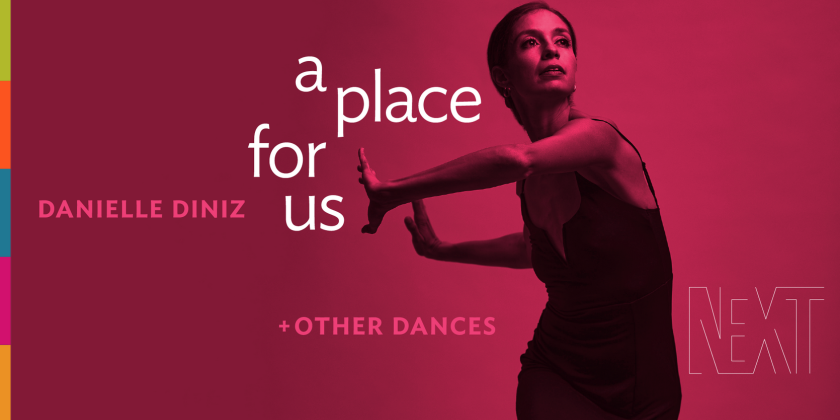AUDIENCE REVIEW: Accent Dance presents "First Look: A Place for Us + Other Dances”

Company:
Accent Dance
Performance Date:
September 6
Freeform Review:
This past Friday, September 6th, Accent Dance presented “First Look: A Place for Us + Other Dances” at the Open Jar Studio, with works by choreographers Falosha Martin, Pedro Ruiz, and Danielle Diniz. It was a diverse and lively performance featuring dance from a broad range of genres and styles.
The night began with a work entitled Yamana, by choreographer Falosha Martin featuring drumming by Desmond Howard. The piece starts with the lights dim and Martin ever so slowly descending onto the stage. In the darkness, we hear the rhythm of the drums, inviting the dancers and audience in as one. As the lights slowly brighten, two dancers in long, brightly patterned dresses enter the stage. Their legs are quick and agile, feet entering and leaving the ground within a singular beat. The lower body shifts between external and parallel positions, suggesting a sense of freedom to explore. The rooted nature of the lower body mixed with the artistry of the movements, created a beautiful dichotomy between art and athleticism. There are distinct moments when the dancers move together in unison, gazing towards the drummer as though a conversation is taking place, one where motions and movement become the medium of communication. One specific quality that stood apart from the rest is the prominent and continuous undulation of the body, more locally through the torso region. The motions of the spine are fluid and clear, as if using the trunk of the body as a means to create a deeper dialogue with the audience. As the torso moves, the head becomes a continuation of the upper body, jutting forward and backward beyond the midline of the body.
The second piece, titled La Bella, has a sense of ease and effortlessness, mixed equally with determination and persistence. The arm movements maintain a sense of breath, far beyond the lungs and ribcage, as if each sequential exhalation traveled to the end of the fingertips. The duet flowed in and out of various positions leaving me questioning what might come next. With breath in the arms and movement in the legs, this contrast emerged within each dancer's own unique body, reminding us that two truths can be held within the same space and time. As the dancer on pointe finds various positions of balance on one leg, the male dancer is there to catch her each time. There is a strong sense of trust among the dancers, both rooted in their own technique and trust in their partners ability to pick up where gravity left off. The work is strongly technical with its classical lines, traditional partnering, and clarity of movement. Simultaneously, the piece embodies a more contemporary feeling with its take on weight-sharing, paying homage to more contemporary choreography with fluidity and gusto. As the piece concludes, the male dancer carries the female off stage, an ending blooming with connection. The dancers are at home as they are together.
In the third work, La Sofa, also choreographed by Falosha Martin, we see the arms actively gliding through space, creating sweeping motions. As the legs descend into large lunge positions, the dancers gradually move towards each other and then slowly trickle away. There is a sense of community and conversation in this work. A shared feeling of unison to both move and be moved. The level changes encourage each dancer to explore the depth of their physical practice and sense their own physicality. We are reminded in this work that dance can be used as a moment to pause and process our own lives while also taking into account the feelings of those around us. As the dancers make large circular patterns around the drummer, it so beautifully demonstrates how dance mixed with music is one of life’s most treasured pairings.
A Place for Us, choreographed by Danielle Daniz, is energetic, upbeat, and highly engaging. The work involves three soloists, all of whom enter a new space that at first feels like wildly unfamiliar land. The first soloist that enters wears a bright yellow dress and a flower in her hair. Her movements are inviting, welcoming the audience into this new world. The dancer embodies a personality that feels confident and at ease. The second soloist includes a dancer wearing all blue, seeming to float through space. Similar to a surfboard moving up and down, there is a sense of flow from within, at times easy and effortless in the air and at other times low and rooted into the ground. The final soloist wears all red, her face filled with a sense of panic or confusion. It appears that she wants to be in relation to the rest of the dancers while also yearning for her own independence. We see the dancers as they transition from working as soloists to working as a group, easily moving between these different states of being. The choreography itself is diverse and eclectic. The pungent mix of ballet, jazz, latin, and hip hop styles generates a type of work that is deeply unique to Diniz. The movements are well crafted and curated while leaving space for each individual dancer's unique abilities to shine through. The piece concludes with the dancers weaving in and out of one another and then running forward and pausing. The conclusion feels dramatic, as if the movement is washing over us.
The show demonstrated a wide variety of techniques and styles, illustrating that dance thrives in a space of rearrangement and reconstruction. Dance is dialogue, dance is culture, and dance is community. As we continue to use the powerful mechanism of the art form as a means of storytelling, movement creates space for stories to be shared through each choreographer's individual lens.
Author:
Rachel Marchica
Photo Credit:
Accent Dance













